By Kenton X. Chance
The usually sleepy northern Grenadine island of Bequia, known as the place, even among Vincentians, to relax and unwind, came alive on Thursday as whalers began processing the 50-foot female humpback whale caught one day earlier.
Hundreds of persons travelled to Semple Cay, off Bequia’s southern coast, where the whale processing facilities are located.
Many came with buckets and sacks to buy or beg for meat and blubber, while others, such as 15-year-old Shantel Baptiste, who took the day off from school, came just to watch.
The killing of the cetacean, as part of the island’s 142-year-old whaling culture, has opened up a fresh round of discussion about whether whaling should continue on the northern Grenadine island, where, like the rest of St. Vincent and the Grenadines, tourism is the mainstay of the economy.
Bequians, as the island’s residents are called, regardless of where they stand on the island’s whaling tradition, are, by and large, interested in the whaling-related activities on the island.
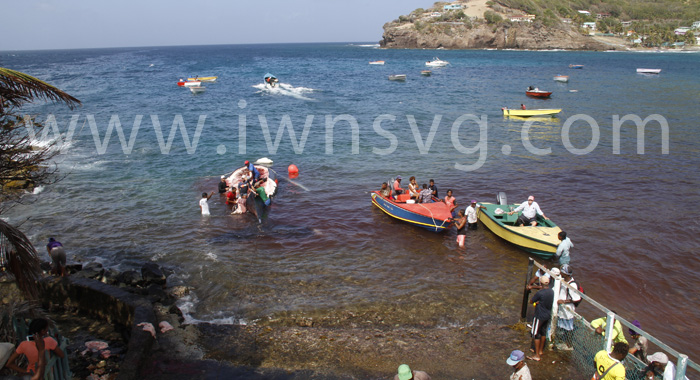
Hundreds of persons went to watch the whale being cut up or to buy meat. (iWN photo)“This is the first time I’m coming here to see a big whale. I’ve never seen a whale in my life. I am surprised to see a whale. I’m so happy. I do not eat whale but still I’m happy for the people who eat whale,” Baptiste told iWitness News while witnessing the cutting up of the whale on Semple Cay.
Baptiste does not eat whale not because of any overarching philosophy, but simply because she does not like the taste or the smell of the meat, which she said is rank.
But still, she wanted to be part of the celebrations that engulf the island whenever a whale is caught.
She told iWitness News that she doesn’t think that whales that are “too young” should be caught. However, she didn’t know if she thinks that the island’s residents should continue whaling.

Whaling was introduced in Bequia in 1875, and, since then, the style and method of whaling has not changed much. The whalers still use sailboats to search for and harpoon whales.
The International Whaling Commission (IWC), which governs whaling globally, was set up to “provide for the proper conservation of whale stocks and thus make possible the orderly development of the whaling industry”.
The IWC allows Bequians to kill four humpback whales every year as part of their aboriginal subsistence culture, but the whalers sometimes go for years without a single catch.
According to a June 2012 report for the International Whaling Commission, compiled by the Animal Welfare Institute, since 1981, Bequia whalers are reported to have struck and landed 29 humpback whales and struck and lost at least five more.
Since then, whalers have killed an average of one whale every other year.

Some persons took the day off from work or school to participate in or observe the activities on Semple Cay. (iWN photo)Among those who support whaling is Orwell Ragguette of Paget Farm, Bequia. “I think whaling is good for our culture, our people, our heritage, the country,” he told iWitness News from his perch on a rock on Semple Cay, from where he was observing the whale being cut up and sold.
“It is a tradition started from years back and we cannot kill our tradition because of someone else. It is food for everyone in the country. And when you catch a whale, it makes the country [come] alive. Everybody come together, you get a piece of whale and it makes everybody feel happy and nice.”
Among those opposed to whaling is Louise Mitchell, a Kingstown-based attorney and conservationist, who is originally from Bequia.

Mitchell, who is also the coordinator of the SVG Preservation Fund — which “ gives support to local sustainable initiatives geared at conserving the delicate ecosystem of the islands and to ensure that its natural beauty is sustained through the ages” — told iWitness News that while the IWC allows Bequians to whale as an aboriginal subsistence activity, she does not think that Bequia’s whalers meet those qualifications.
She noted that aboriginals are indigenous peoples, adding that Scottish settlers started whaling in Bequia in the late 19th Century.
“So it was certainly not an activity started by the Amerindians,” she said, adding that whaling is also not needed for subsistence.
“So, on that basis, we do not need to be killing whales,” she said, adding that humpback whales are magnificent creatures and Vincentians should be enjoying the fact that they come to the nation’s waters to raise their calves.
“So, there is a great chance that because it was a mother that was killed, she had a calf with her, who would be now wandering around without a mother, because, as you know, whales breastfeed like women do,” Mitchell said of the species that gives birth every two or three years.
But whether whaling meets the aboriginal or subsistence criteria, many Bequians consider it an important part of the island’s culture, as reflected by Ragguette’s comments.
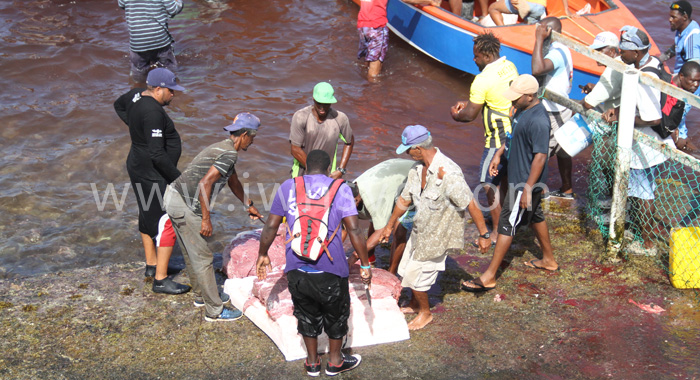
Whaling has been a part of Bequia’s culture for almost 150 years. (iWN photo)Mitchell, however, believes that that was the case in an era past.
“I believe it was an important part of the culture. I don’t think it is currently an important part of the culture. I think it is something we can dispense with. I think it should be an honoured part of our history,” said Mitchell, who is also a trustee of the Bequia Heritage Foundation, a group that has set up a whaling museum in Bequia.
“In the days when we didn’t have electricity, whale meat was something that could be corned and preserved for a long time. It was absolutely critical at one point in our development. In this day and age, we no longer need it, and I think we should shift away from it.”
Mitchell advocates whale watching as an alternative, which Ragguette says he does not think “will really make it” in St. Vincent and the Grenadines, noting that the whales that visit the nation’s waters are fast moving.
“Whale watching is more for like sperm whale; not humpback whales that feed around here,” Ragguette said.
Ragguette is not a passive supporter of whaling, as he also consumes whale meat. “The taste is difficult to describe. It is a special taste. I won’t say I like it. I would say I love it. I enjoy it,” Ragguette said.
He had taken the day off from work to watch as the whale was being processed and to secure his own piece of the catch. “I work but I have to take a day off because this is beyond a festival.”
Kingsley Stowe, who learnt the whaling skill from the late Othneil Ollivierre — dubbed by a calypsonian as “the greatest whaler man” — killed Wednesday’s whale.
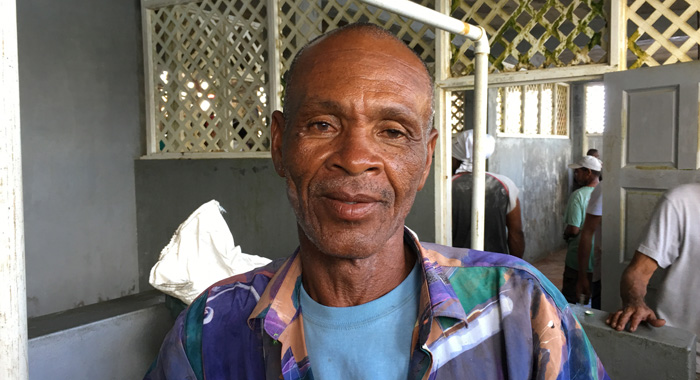
Kingsley Stowe plans to continue whaling “until the Lord says no more”. (iWN photo)Stowe told iWitness News that he and his crew set out around 9 a.m. and spotted the lone whale off Pigeon Island, some two miles south of Bequia.
“The wind was really heavy but I managed to harpoon that one yesterday,” Stowe told iWitness News, adding that the whale took about 30 minutes to die, by which time they had travelled about “from St. Vincent to Bequia” — a distance of nine miles.
Stowe, who is “turning 60”, has been whaling for more than 30 years.
During that time, he has killed about 12 whales, including a few while he was under Ollivierre’s tutelage.
Since branching off on his own, he has caught about eight whales, he told iWitness News.
He said that outfitting a whaling boat is “very expensive”. Money has to be spent on getting boats, equipping them with ropes and lances, and, of course, crews. “It’s over a hundred thousand dollars you are looking at,” he told iWitness News.
On Wednesday, seven persons went out to whale, and a support boat had a further seven.
“If all goes well with that whale, we would make about $45,000,” Stowe said, adding that if they catch the four whales permitted under the IWC, he could “expect to get a little raise (fortune) from it”.
But other sources told iWitness News that the whalers could expect to make as much as EC$100,000 from the whale, which had a girth of 28 feet.
And herein lies the challenge in convincing the whalers that whale watching is a more economic alternative, especially in light of the fact that very little of the whale carcass — except, maybe, the entrails — goes to waste.
Stowe told iWitness News that the oil is extracted from the blubber and the meat is cooked. “They use everything from it. The bones, people use it to make stool and the ribs, they decorate with them,” he said, noting that they have been used to make arches at the entrance to some business places on Bequia.
The experienced whaler noted the opposition to whaling, but rejected the argument.
“I don’t understand what some people are saying, because, if you are here, a few minutes from now, all [the whale meat will be] gone, you know. So, I don’t see no interest in whale watching because that don’t bring any benefit. And nobody is going to go whale watching. We don’t see whale here every day. It is just now and again. By next week, you might not see any; they might be all gone. That wouldn’t work; whale watching wouldn’t work,” he said.

Tourism is the mainstay of the Vincentian economy. (iWN photo)Mitchell believes that whaling is not good for the tourism industry in St. Vincent and the Grenadines, especially when it has just commissioned its first international airport.
“We are inviting people to come from all over the world and when we put out brochures about what you have in St. Vincent and the Grenadines, we have pictures of turtles and pictures of dolphins. We do not market the fact that we kill whales and we would not be able to market that, because people wouldn’t come if they knew we did that,” she said.
Mitchell said conservation has to be looked at not just from the point of view that it may be morally right, but that it also makes economic sense.
The humpback whales killed by Bequia’s whalers are migratory can come to the warmer waters of the region just for a few months each year.
But Mitchell said whale watching is a real option in St. Vincent and the Grenadines, adding that persons would pay at least US$50 “to go and see whales and dolphins”.
She said that certainly, on the leeward coast of St. Vincent, where the waters are calmer, whale watching “is a viable activity”.
“If you just go off about two or three miles, you will always see at least dolphin, so it is an absolutely viable alternative that should be explored,” she said, adding that Vincentians do not like change.
She used the banana industry as an example, saying that no matter what diseases come, farmers still want to plant bananas and the opposition is still criticising the government because the banana industry is not doing better.
Mitchell said that SVG’s waters have sperm whales “a lot of the time throughout the year.
“There are many different species that are there at different times,” she said, adding that killer whales are in the nation’s waters several months of the year and dolphins are there year round.
“There’s always something to see. Some species may come at different times than others so there is definitely always something to see out there,” she said.
SVG’s whaling quota is up for renewal in 2018 and indications are that barring the intervention of the IWC, whaling will continue in Bequia and Barrouallie — a town on St. Vincent’s west coast where the killing of pilot whales, and, periodically, orcas is a decades-old tradition.
For his part, Stowe plans to whale “until the Lord says no more.
“I ain’t see no reason to stop,” said Stowe, whose crew includes one of his sons.
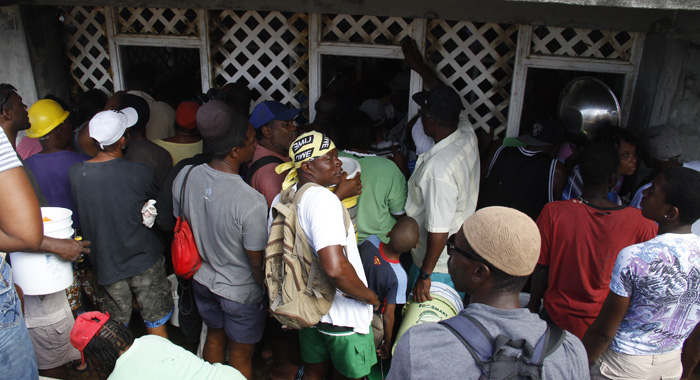
Persons cue up on Semple Cay to buy whale meat last Thursday. (iWN photo)Among the crew who killed the whale on Wednesday were three young men in their late 20s and early 30s.
“This thing is a tradition. You see who dey here, the young generation, we’re carrying on the tradition,” Allistair Kydd declared to iWitness News at Semple Cay on Thursday.
“I have two youth (children) and ah (I) don’t want to draw it on [a] piece ah paper and tell them that is what whale look like and what it taste like.
“This is we country, we’re supposed to have we free rights and to say and do what we want in we country. We ain’t want no dictatorship from nobody outside to tell we wha’ fuh do with food wha’ master God put on the earth. The Bible say bless and eat,” he said.
“You see this?” he said, holding up a chunk of raw whale meat. “We praise and thank God that we eat a piece a whale meat this year, because me throat hoarse. Is a good thing I get piece to shine it up and thing,” Kydd further stated.
But Mitchell, who is daughter of a former prime minister, Sir James Mitchell, whose government had negotiated the renewal of Bequia’s whaling quota, noted that hers is not a voice from outside.
“All I ask you is where was I born? Am I Vincentian?” she asked iWitness News rhetorically. “The whalers in Bequia, most of them are my family. We come from the same genetic pool.”
She further noted that SVG is a part of the international community.
“They cannot say it is imposed from the outside because we are a member of the IWC and we say we are going to respect their laws. Right now, the IWC’s quota is the reason why we can justify killing the whales in Bequia. Well, if that quota isn’t renewed, they won’t be able to kill them anymore.”
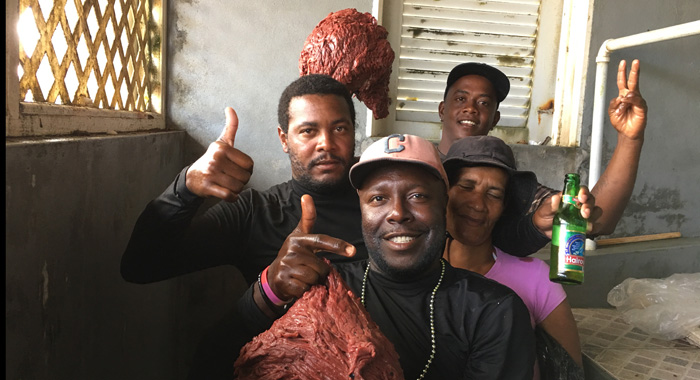
But the young whalers, in defending their practice, swear by what they say are the medicinal properties of whale meat and oil.
“For the young generation, when you get cold and you can’t go to the hospital, you just get some whale oil and put some lime and salt and that is the best thing for the youth them growing,” said Keon Hazell, whose job on the whaling boat was to wet down the rope after the whale was struck to prevent it from catching fire as the whale swam at high speed.
After the whale died, Hazell and Kydd sew up the whale’s mouth to prevent its stomach from filling with water and result in the whale sinking.
“It was really dangerous yesterday to be swimming in that water with no bottom,” Hazell said, adding that the whale died about 13 miles off West Cay, a cay to the western tip of Bequia.
The men are convinced that whaling has a secure future in Bequia.
“Whaling and Easter Regatta, we ain’t want no outsiders coming and contradict we system here. This is we tradition, we live by, we enjoying it and we can’t go in another man country and tell them what fuh (to) do. So, we ain’t want nobody come in we country and tell we wha’ fuh do. We want freedom for we whale and we want freedom for we Easter Regatta. Them is two things we fighting for,” Kydd told iWitness News.







I am a “voice from the outside,” a North American who has been a regular visitor to SVG for more than twenty years. Most of my time has been spent on Bequia, although I have visited most of the Grenadines, as well. I have climbed Soufriere, anchored in Chatham Bay, travelled to Union on the “slow ferry” more than once, spent glorious hours at Montreal Gardens, waded at Owia, hiked the Vermont Nature Trail, been awakened before dawn by Fairhall’s roosters and dogs, and gazed happily at “the big island” from Bequia Head… Among many other wonderful adventures.
I also happened to be on Bequia several years ago when a whale and her calf were taken. Word spread like wildfire over Bequia. Very early the next morning, my husband and I went to the windward side of the island, and were immediately picked up and tossed literally into a boat heading out to the whaling station.
The scene was overwhelming, and the excitement contagious. As a North American, I had all those preconceptions about the wonderfulness of whales, and how “awful” it was to kill them. And then I met an older woman probably younger than I am now, actually. She was carrying two plastic buckets, one for the meat, one for the blubber. I asked her if the meat was good. She replied, “Oh, yes. We eat de whale, we strong for a year.” I believed her.
“Whale steaks” were never offered on any restaurant menu. I learned that all was divided among the whaling crew, and their families and friends, according to a long-standing formula, based on each whaler’s position on the boat. There was nothing wasted here, and nothing was done “for tourists.” All was done as it had always been done.
I learned a great lesson that day, and an important one for person who long believed that chickens appear magically wrapped in plastic at the grocery, and that “fish” are rectangular pieces coated in bread crumbs. Obtaining food requires an incredible amount of work, strength, and skill, and all is sacred. This is very much like the reverence our Original Peoples here in the United States have for the lives of the animals whose deaths sustain them.
Obviously, the Tourism Ministry would not say anything remotely like, “Come to St. Vincent and the Grenadines, and watch us kill whales.” What discourages visitors is evidence of an impoverished populace, lack of adequate infrastructure, escalating prices, and apparent governmental neglect of natural attractions. But you Vincys know all of that, and always have…
(I must add, also, that I was surprised to read this article and find no mention, at all, of the great Athneal Ollivierre, whose legacy and pride I assume lives today in the heart of every whaler who has the courage to climb aboard a boat and head out to sea in search of a great catch…)
For this courage, and for everything else that makes you Vincys, you continue to have my deepest admiration, respect, and affection.
“Kingsley Stowe, who learnt the whaling skill from the late Othneil Ollivierre — dubbed by a calypsonian as the greatest whaler man — killed Wednesdays whale.”
Louise Mitchell is a Vincentian, but she is part of the colonial class. Her parents are white Canadian and Scottish descendant of Bequia. I am sure she knows her history very well, and because of that she would have been more understanding to this issue.
The majority of the whalers are of African descendants. Louses family chose to live on Bequia. The African descendant did not, they were forcefully removed from Africa and relocated to Bequia as slaves.
Culturally genocide was not committed to Louises descendant. The same cant be said of African descends. African descendants were not allowed to speak their languages, practice their religions, and practice their cultures.
For Louise to say whaling is not indigenous to Bequia because the people are not indigenous is very disingenuous, because Africans were brought in as slaves to replace the indigenous population who were almost completed annihilated by diseases, and overwork from the European settlers and slave masters.
Whaling have been adopted from the white settlers by the mostly poor African descendants. What are people do when they have lost their entire culture, ways of life, and traditions? Whaling is something that keep the people together. One or two whales per year that feed the entire islands will not harm the whale population.
It is very disappointing to see Louise on the other side of this issue. I hope she change her mind and become an advocate for the brave whalers and the people of Bequia being able to continue the subsistence whaling program. Being an advocate for the whalers is by no means being anti-conservationist. The people of Bequia are the ultimate conservationists, nothing get wasted. It is just a way of life not a fad.